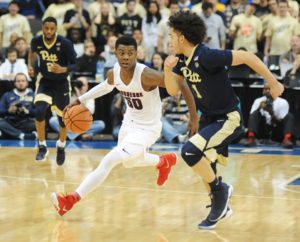
David Borne | Staff Writer
12/07/2017
Since the 1978-79 season, there have only been two Duquesne freshmen to post three double-doubles in their first six NCAA games: Dukes all-time great Bruce Atkins and freshman Eric Williams Jr.
Coming into the season, Williams wasn’t a name that many Atlantic 10 basketball fans were too familiar with. It’s more than fair to say that they should be now.
Despite an accomplished high school career, the Michigan native flew under the radar as a recruit. He averaged 20.9 points and 6.5 rebounds per game during his senior year and led New Haven High School to a 27-1 season that ended with the hoisting of a MHSAA Class B state championship trophy.
Not discouraged by a lack of offers from bigger programs as his senior season continued to progress, Williams continued to work on his game, remaining focused on his final season of high school basketball.
“I realized that I didn’t really play for a big AAU team, so going into my senior season I realized I would have to do well,” Williams said. “It started coming around by the end of my senior season, but nobody wanted to be the first ones to offer me.”
One of the coaches that did take notice was then-Akron assistant coach Charles Thomas. Following Williams’ state championship game performance, Thomas reached out to Williams. After Thomas followed Keith Dambrot to Duquesne, Williams got the offer he was waiting for.
“I first spoke with Coach Thomas; this was before he was at Duquesne, he was at Akron. He kept talking to me,” Williams said. “He was telling me he might come to Duquesne so I chose to wait it out. Then it all ended up working out when I came on a visit.
“I just kept waiting around, and finally Duquesne came and offered me,” he continued.
Through his first six games at Duquesne, the freshman is second on his team in scoring, averaging 16.0 points per game, putting up a career-high 24 points in Duquesne’s 86-61 win over Maryland Eastern Shore on Dec. 4. Williams trails only sophomore Mike Lewis II, who leads Duquesne in averaging 16.2 ppg through the team’s first six contests.
On top of his impressive knack for putting the ball in the basket, the 6-foot-5 Williams has proven to be Duquesne’s strongest rebounder.
Williams really started to focus on hitting the glass consistently during his senior year of high school, and found success that has carried over to the collegiate level. He is currently pulling down 9.67 rebounds per game and has at least eight rebounds in every game this season.
His defensive rebounding percentage (23.9), which is an estimated percentage of missed shots rebounded while on the floor, ranks fourth-best amongst A-10 players to date.
Additionally, Williams’ ability to crash the boards on the offensive side of the ball has created a number of second-chance scoring opportunities for himself and for his teammates, as well.
“It creates opportunities for me offensively,” Williams said of rebounding so well as a guard. “I’m working on kicking it out after I get the offensive rebound so it creates opportunities for others, as well.”
Keith Dambrot and his staff are known for finding unrecognized recruits and developing them into top talent. Williams’ early play makes it seem as though he is yet another testament to that.
Coming into the season, many questions about Duquesne’s team were centered around who would help Mike Lewis II carry the load offensively, and how the team would manage to rebound and play in the paint with such a limited inside presence.
So far, Williams has answered both of those questions emphatically, and is another important piece of the future for coach Dambrot and his staff. While many Dukes fans are really just focused on the years to come for the program, Williams and his team are still looking to make as much noise as they can in the present.
“I’m just glad to start here and keep building from where we are. We’re going to have a lot of depth next year and then years to continue,” he said.
One of the biggest keys to becoming a successful mid-major is a program’s ability to spot and bring in unrecognized talent that can arrive and make an impact over a prolonged period of time. Duquesne had a similar story last season following the emergence of Mike Lewis II, and now Williams seems to be following Lewis’ path in a similar manner.
With the two impressive underclassmen leading the way, the future is bright for Duquesne.



